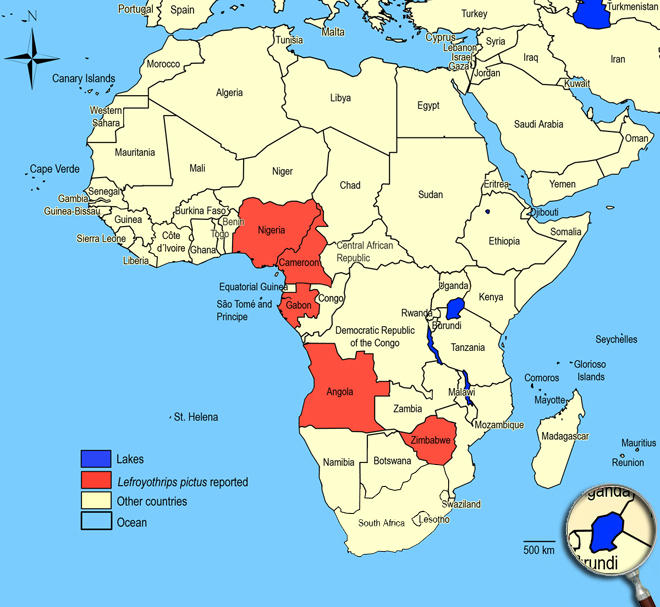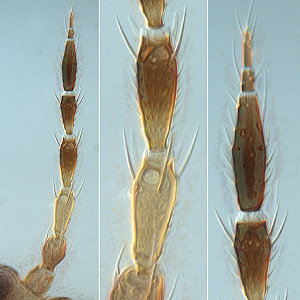Lefroyothrips pictus (Hood, 1916)
Thripinae, Thripidae, Terebrantia, Thysanoptera
Figures
Fig. 1: 8-segmented antenna, segments III and IV with forked sense cone, terminal segments V-VIII
Fig. 2: Head dorsal with ocellar triangle
Fig. 3: Pronotum
Fig. 4: Meso- and metanotum
Fig. 5: Fore wing and fore wing middle region
Fig. 6: Tergite VIII with posteromarginal comb
Fig. 7: Tergites VIII and IX
Fig. 8: Tergites IX-XI
Introduction and Recognition
Lefroyothrips pictus is a pest in flowers of ligneous plant species like citrus, tea, and Persian lilac (Melia azedarach). Both sexes fully winged. Body bicolored; yellow with antennal segments VI-VIII and apical half of IV & V brown; pterothorax with brown markings; tergites III-V brown in anterior half, VII & VIII with a transverse brown band, most of IX & X brown; all legs and head pale to yellow; fore wings banded with base pale, dark submedian stripe and apex. Antennae 8-segmented; segments III & IV with constricted apical neck and forked sense cone (Fig. 1). Head wider than long; with a shallow occipital ridge; 3 pairs of ocellar setae present, setae III very long, longer than pair II, and arising close together well within the ocellar triangle; postocular setae small (Fig. 2). Pronotum with 2 pairs of long posteroangular setae; posterior margin with 3 pairs of setae (Fig. 3). Mesofurca with spinula. Metanotum median area with transverse sculpture at anterior and weak sculpture on posterior half; median setae longer than lateral setae and arise at anterior margin; campaniform sensilla present (Fig. 4). Mid and hind tarsi 2-segmented. Fore wing first vein with 7 setae basally and 3 setae distally; second vein with complete row of about 13 setae; clavus with 4 marginal setae (Fig. 5). Tergites without sculpture and without ctenidia; tergite VIII with irregular group of microtrichia anteromesad of the spiracle, and with a complete comb of long and slender microtrichia on posterior margin (Fig. 6-8). Sternites without discal setae; median pair of marginal setae on sternite VII arise at margin.
Male similar to female; tergite IX with 3 pairs of spinelike setae whose bases from an almost perfect hexagon; sternites without glandular areas.
Taxonomic Identity
Species
Lefroyothrips pictus (Hood, 1916)
Taxonomic history
Taeniothrips pictus Steinweden, 1933
Physothrips pictus Hood, 1916
Common name
-
Present taxonomic position
Family: Thripidae Stephens, 1829
Subfamily: Thripinae (Stephens) Karny, 1921
Genus: Lefroyothrips Priesner, 1938
Genus description
The genus Lefroyothrips Priesner, 1938
This genus includes 4 flower-living species from the Old World tropics. They are probably closely related to Taeniothrips, but with 3 pairs of ocellar setae. Furthermore, members of the genus have 8 antennal segments, antennal segments III & IV with forked sense cone, the pronotum contains 2 pairs of long posteroangular and 3 pairs of posteromarginal setae, tergite VIII without ctenidia, but with a complete comb of slender microtrichia on posterior margin.
Species description
Typical key character states of Lefroyothrips pictus
Coloration and body sculpture
Body color: distinctively bicolored
Surface of head, pronotum and fore legs: without obvious or with weakly reticulate sculpture
Antennae
Form of sense cones on antennal segments III and IV: emergent and forked on segments III and IV
Number of antennal segments: 8
Antennal segment I: without any setae on dorsal apical margin
Antennal segment II: without an exceptionally long seta at the inner apex
Antennal segment II shape: symmetric
Antennal segment III shape: symmetric
Length of antennal segment III and IV: antennal segment III similar in length to segment IV
Forked sense cone on antennal segment IV: scarcely extending beyond base of segment V
Antennal segment IV and V: without a hyaline ring near the base
Antennal segment VI bears: not a remarkably dagger-shaped sensorium
Head
Distance between bases of ocellar setae III: same or less than width of first ocellus
Head: not prolonged in front of compound eyes
Ocellar setae I: present
Length of ocellar setae II: shorter than setae III
Ocellar setae III: arising within ocellar triangle (mainly anterior to tangent of anterior margin of hind ocelli)
Ocelli: present
Length of postocular setae: not alternating short and long setae
Number of ocellar setae: 3
Prothorax
Number of pairs of long anteroangular setae: 0
Number of pairs of long posteroangular setae: 2
Number of pairs of elongate pronotal setae: 2
Number of pairs of posteromarginal minor setae: 3
Pronotal blotch or internal apodeme: absent
Pronotum shape: broadly rectangular
Pronotum posteromarginal/posteroangular setae: S2 longer than S3, not equal in length
Mesothorax
Mesosternal furca: with median spinula
Metathorax
Metanotal campaniform sensilla: present
Metanotal median setae: S1 at anterior margin
Metanotum with dominant sculptured triangle medially: absent
Metasternal furca: without spinula
Sculpture of metanotum median area: transverse at anterior, but scarcely sculptured on posterior half
Shape of metathoracic furca: transverse, V-shaped
Metanotal median setae length: longer than lateral metanotal setae
Wings
Fore and hind wings: present, more than half as long as abdomen (macropterous)
Fringe cilia arising: from sockets
Fore wing veins: present
Fore- and hind wing surface: covered with microtrichia
Apex of fore wing: with prominent terminal setae
Fore wing anterior margin (costal vein): with setae and cilia but cilia longer than setae
Fore wing costal fringe cilia: arising at anterior margin of wing
Fore wing first vein: distinct from costal vein
Fore wing first vein setal row: incomplete, with setae not closely and uniformly spaced
Fore wing second vein setal row: complete, setae uniformly spaced
Fore wing shape: mainly parallel sided or margins run continuously towards each other
Fore wing surface: not reticulate
Fringe cilia on posterior margin near apex: distinctly wavy (undulated)
Length of fore wing costal setae at middle of wing: longer than half of median wing width
Shape of fore wing apex: with mainly posterior margin curved to join anterior margin
Fore wing extreme apex color: dark
Fore wings: alternating bands of dark and light
Legs
Fore tibia: not prolonged around fore tarsus
Mid and hind tarsi: with two segments
Color of fore tarsi: pale or yellow, sometimes apical shaded or brown
Abdomen
Pleurotergites: not covered in microtrichia
Sternite II: with marginal setae but no discal setae
Sternites IV, V and VI: with marginal setae but no discal setae
Sternite VII median posteromarginal setae S1: arising at posterior margin
Sternite VII: with marginal setae but no discal setae
Surface of lateral thirds of abdominal tergites: without regular rows of fine microtrichia
Tergites II to VII median setal pair: no more than 0.3 as long as median length of tergite
Tergites IV and V median setal pair: shorter than distance between their bases
Tergites V to VII: without ctenidia laterally, but sometimes with rows of microtrichia
Craspedum on tergites IV to VI: absent
Craspedum on tergite VIII: without craspedum medially and toothlike microtrichia laterally
Tergite VIII ctenidia: without paired ctenidia laterally, sometimes with irregular microtrichia
Tergite VIII posteromarginal comb of microtrichia: present and complete medially
Tergite VIII shape of posteromarginal microtrichia: long, slender and irregular or regular
Tergite X: not tubular, longitudinally incomplete
Setae on abdominal tergite X: all setae slender

Similar or related species
Lefroyothrips pictus is similar to species of Ceratothripoides and Craspedothrips, Diarthrothrips coffeae, and Megalurothrips sjostedti in having 8-segmented antennae with forked sense cone on segments III and IV, a pronotum with 2 pairs of long posteroangular setae and 3 pairs of posteromarginal setae (species of Ceratothripoides with 3-4 and Diarthropthrips coffeae with 2-3 pairs of posteromarginal setae), and tergites V-VIII without paired ctenidia laterally. Lefroyothrips pictus as well as species of Ceratothripoides differ from other species by the complete posteromarginal comb of long and slender microtrichia on tergite VIII, whereas other species have a continuous craspedum (Craspedothrips hargreavesi), no comb of microtrichia (Craspedothrips xanthocerus, Diarthrothrips coffeae) or a comb of short microtrichia only laterally on posterior margin of tergite VIII (Megalurothrips sjostedti). Compared to Lefroyothrips pictus with distinctly bicolored body color, antennal segment I without any setae on dorso-apical margin, metanotal median area scarcely sculptured on posterior half, and median pair of marginal setae on sternite VII arising at margin, species of Ceratothripoides possess usually a uniformly brown body color, antennal segment I bears a pair of small setae on dorso-apical margin, metanotal median area always sculptured with equiangular reticulations on posterior half, and median posteromarginal setae on sternite VII arise always in front of margin. Furthermore, species of Ceratothripoides have the fore wings usually uniformly brown or uniformly pale or yellow, compared to Lefroyothrips pictus with banded fore wings.
Biology
Life history
As with other thrips species the life cycle from egg to adult is dependent on temperature. The full cycle can take about 15 days (Lewis 1973) to over a month and adults may live for more than one month producing several generations in one year depending on seasonal weather.
Host plants
On flowers of ligneous plant species: Citrus, Melia azedarach (Persian lilac), tea (Camellia sinensis).
Vector capacity
None identified, but possible mechanical distribution of phytopathogenic fungi and bacteria.
Damage and symptoms
-
Detection and control strategies
-
Additional notes
-
Biogeography
Afrotropical Region. Angola,
Cameroon (Ngaoundéré - Adamawa Province), Gabon, Nigeria (Ibadan), Zimbabwe.
African countries where Lefroyothrips pictus has been reported

The species Lefroyothrips pictus was not observed in surveys undertaken in East Africa on vegetables and associated weeds and crops.
Please click here for survey sites of all observed thrips species of Kenya, Tanzania and Uganda.

Bibliography
Bhatti JS (1978). A preliminary revision of Taeniothrips (Thysanoptera: Thripidae). Oriental Insects. 12 (2): 157-199
Bournier A (1970). Thysanoptéres du Gabon. Extrait de la Revue Biologia Gabonica. 6 (2): 151-168
Hood JD (1916). Descriptions of new Thysanoptera. Proceedings of the Biological Society of Washington. 29: 109-124
Lewis T (1973). Thrips: their biology, ecology and economic importance. Academic Press Inc., London Ltd., 349 pp
Moulton D (1940). Thysanoptera from New Guinea and New Britain. Occasional Papers of Bernice P. Bishop Museum (HBS-Bishopmuseum), Honolulu, Hawaii. 15 (24): 243-270
Palmer JM (1990). Identification of the common thrips of Tropical Africa (Thysanoptera, Insecta). Tropical Pest Management. 36 (1): 27-49
Pitkin BR & Mound LA (1973). A catalogue of West African Thysanoptera. Bulletin de ľInstitut Fondamental ďAfrique Noire, Série A. 35 (2): 407-449
Priesner H (1938). Materialen zu einer Revision der Taeniothrips-Arten (Thysanoptera) des indomalayischen Faunengebietes. Treubia. 16: 469-526
zur Strassen R (1983). Thysanopterologische Notizen (6) (Insecta: Thysanoptera). Senckenbergiana Biologica. 63 (3-4): 191-209
----
Web links
Mound´s Thysanoptera pages
Thysanoptera Checklist
ICIPE Thrips survey sites
UNI Halle & Thrips sites
Thrips of California











